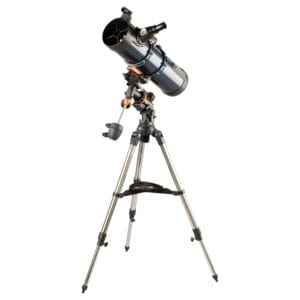A good beginner’s telescope helps you discover the moon, planets, and bright deep-sky objects without frustration. Yet many people buy the wrong model: too complicated, too weak, or much too large. In this blog, you’ll learn which telescopes are good for beginners, how magnification works exactly, and which mistakes to avoid.
With Telescopes, It’s Often about Magnification. But how Does it Work Exactly?
Every telescope has a so-called focal length – this is the distance light travels in the tube before it’s focused. At the end, you place an eyepiece, which acts as a magnifying glass for the image the telescope captures. You calculate the magnification as follows:
Magnification = telescope focal length ÷ eyepiece focal length
An example: if your telescope has a focal length of 650 mm and you use a 25 mm eyepiece, the magnification is:
650 ÷ 25 = 26x magnification
If you use a 10 mm eyepiece, you get:
650 ÷ 10 = 65x magnification
What is the Maximum Magnification a Telescope Can Handle?
While it sounds tempting to “zoom in as far as possible”, there’s a limit to what a telescope can handle. A useful rule of thumb is:
Maximum useful magnification ≈ 2x the lens or mirror aperture in millimeters
If you have a telescope with a 130 mm mirror (you can read this from the first number. If it says 130/650, the lens aperture is 130mm), then the maximum usable magnification is approximately 260x. Anything above that usually results in a dark or blurry image — especially with cheap eyepieces or under poor viewing conditions.
Moreover, the atmosphere itself is often the limiting factor. Turbulence in the air (also called seeing) makes high magnifications practically useless on many nights.
For beginners, magnification between 25x and 100x is most useful in practice. With this, you can already see beautiful details on the moon, Saturn’s rings, Jupiter’s cloud bands, and some nebulae under good conditions.
The Best Telescope for Beginners: our Top 4
These models are selected based on simplicity, quality, and value for money. They come from our stargazing guide and are perfect for beginners.
1. Bresser Dobson Telescope N 130/650 Messier DOB
This compact tabletop Dobsonian is powerful, light-efficient, and stable. Ideal for those looking for great value for money.
✓ Suitable for moon, planets, and bright nebulae
✓ Large mirror (130 mm) captures lots of light
✓ Tabletop model: stable, yet takes up little space
Magnification advice: use 25 mm for bright nebulae and 10 or 6 mm for planetary details (the smaller the number on the eyepiece, the higher the magnification).
View the Bresser Dobson 130/650
2. Celestron StarSense Explorer LT 114az
This smart telescope combines classic optics with modern technology. Thanks to the StarSense app, you can easily point it at any celestial object.
✓ Smartphone assistance via the StarSense app
✓ Ideal for beginners without prior knowledge
✓ Lightweight and quick to set up
Perfect for: the moon, Jupiter, and Saturn
Discover the StarSense Explorer LT 114AZ
3. Celestron StarSense Explorer Dobson (N 130/650)
The power of a Dobsonian, combined with smart navigation via your phone. This telescope is ideal for beginners looking for ease of use and performance.
✓ Large mirror (130 mm) for sharp images
✓ App navigation makes stargazing easy
✓ Solid Dobsonian mount
Perfect for: planets, the moon, and open star clusters
View the StarSense Explorer Dobson
4. Omegon Dobson Telescope N 102/640
Small, light, and surprisingly powerful. This 102 mm Dobsonian is an ideal entry model for children or those wanting to start with a compact system.
✓ Light and easy to move
✓ Good optics for its size
✓ Works right out of the box
Ideal for: moon, bright planets, and double stars
More info about the Omegon 102/640
Frequently Asked Questions from Beginners
What Can You See with a Beginner’s Telescope?
✓ Craters on the moon
✓ Saturn’s rings
✓ Jupiter’s moons
✓ The Orion Nebula (in dark skies)
✓ Double stars like Albireo
Which Eyepieces Do I Need?
A 25 mm eyepiece is ideal for wide views (like the moon or nebulae), while a 10 mm eyepiece or lower shows more details on planets.
How much Does a Good Beginner’s Telescope Cost?
Between €200 and €400 you’ll find models that last for years and provide impressive views. It actually becomes more expensive if you choose a cheaper model but quickly outgrow it.
Conclusion: which Beginner’s Telescope is Right for You?
A good beginner’s telescope makes stargazing fun, educational, and accessible. Choose a model that fits your space, ease of use, and interests.
Whether you choose a compact Omegon or a smart Celestron, at telescoop.nl we’ll personally guide you in your first step into the universe.
Tip: also check out our comprehensive beginner’s guide for more explanations and recommendations.








